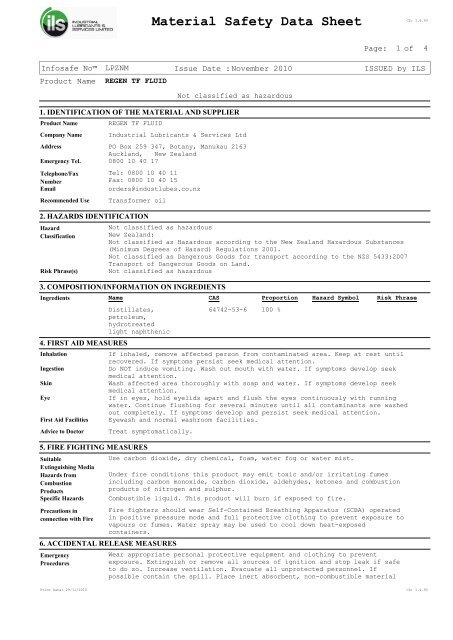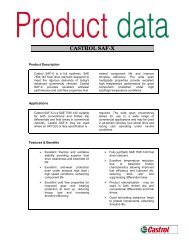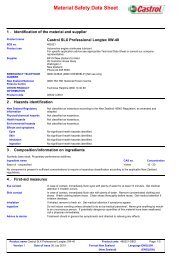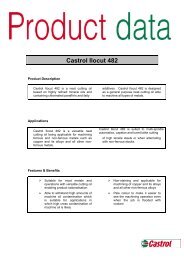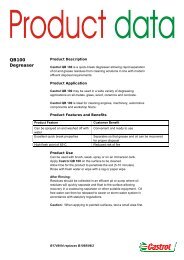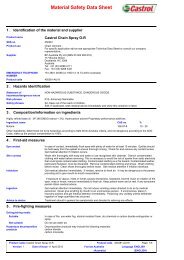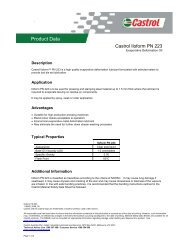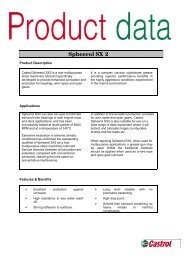Material Safety Data Sheet - Industrial Lubricants & Services Limited
Material Safety Data Sheet - Industrial Lubricants & Services Limited
Material Safety Data Sheet - Industrial Lubricants & Services Limited
Create successful ePaper yourself
Turn your PDF publications into a flip-book with our unique Google optimized e-Paper software.
<strong>Material</strong> <strong>Safety</strong> <strong>Data</strong> <strong>Sheet</strong><br />
CS: 1.4.93<br />
Page: 1<br />
of<br />
4<br />
Infosafe No LPZNM Issue Date : November 2010 ISSUED by ILS<br />
Product Name :REGEN TF FLUID<br />
Not classified as hazardous<br />
1. IDENTIFICATION OF THE MATERIAL AND SUPPLIER<br />
Product Name<br />
Company Name<br />
REGEN TF FLUID<br />
<strong>Industrial</strong> <strong>Lubricants</strong> & <strong>Services</strong> Ltd<br />
Address PO Box 259 347, Botany, Manukau 2163<br />
Auckland, New Zealand<br />
Emergency Tel. 0800 10 40 17<br />
Telephone/Fax<br />
Number<br />
Email<br />
Recommended Use<br />
Tel: 0800 10 40 11<br />
Fax: 0800 10 40 15<br />
orders@industlubes.co.nz<br />
Transformer oil<br />
2. HAZARDS IDENTIFICATION<br />
Hazard<br />
Classification<br />
Risk Phrase(s)<br />
Not classified as hazardous<br />
New Zealand:<br />
Not classified as Hazardous according to the New Zealand Hazardous Substances<br />
(Minimum Degrees of Hazard) Regulations 2001.<br />
Not classified as Dangerous Goods for transport according to the NZS 5433:2007<br />
Transport of Dangerous Goods on Land.<br />
Not classified as hazardous<br />
3. COMPOSITION/INFORMATION ON INGREDIENTS<br />
Ingredients<br />
Name<br />
4. FIRST AID MEASURES<br />
Inhalation<br />
Ingestion<br />
Skin<br />
Eye<br />
First Aid Facilities<br />
Advice to Doctor<br />
Distillates,<br />
petroleum,<br />
hydrotreated<br />
light naphthenic<br />
5. FIRE FIGHTING MEASURES<br />
Suitable<br />
Extinguishing Media<br />
Hazards from<br />
Combustion<br />
Products<br />
Specific Hazards<br />
Precautions in<br />
connection with Fire<br />
CAS<br />
64742-53-6<br />
Proportion<br />
100 %<br />
Hazard Symbol<br />
Risk Phrase<br />
If inhaled, remove affected person from contaminated area. Keep at rest until<br />
recovered. If symptoms persist seek medical attention.<br />
Do NOT induce vomiting. Wash out mouth with water. If symptoms develop seek<br />
medical attention.<br />
Wash affected area thoroughly with soap and water. If symptoms develop seek<br />
medical attention.<br />
If in eyes, hold eyelids apart and flush the eyes continuously with running<br />
water. Continue flushing for several minutes until all contaminants are washed<br />
out completely. If symptoms develop and persist seek medical attention.<br />
Eyewash and normal washroom facilities.<br />
Treat symptomatically.<br />
Use carbon dioxide, dry chemical, foam, water fog or water mist.<br />
Under fire conditions this product may emit toxic and/or irritating fumes<br />
including carbon monoxide, carbon dioxide, aldehydes, ketones and combustion<br />
products of nitrogen and sulphur.<br />
Combustible liquid. This product will burn if exposed to fire.<br />
Fire fighters should wear Self-Contained Breathing Apparatus (SCBA) operated<br />
in positive pressure mode and full protective clothing to prevent exposure to<br />
vapours or fumes. Water spray may be used to cool down heat-exposed<br />
containers.<br />
6. ACCIDENTAL RELEASE MEASURES<br />
Emergency<br />
Procedures<br />
Wear appropriate personal protective equipment and clothing to prevent<br />
exposure. Extinguish or remove all sources of ignition and stop leak if safe<br />
to do so. Increase ventilation. Evacuate all unprotected personnel. If<br />
possible contain the spill. Place inert absorbent, non-combustible material<br />
Print Date: 29/11/2010 CS: 1.4.93
<strong>Material</strong> <strong>Safety</strong> <strong>Data</strong> <strong>Sheet</strong><br />
CS: 1.4.93<br />
Page: 2<br />
of<br />
4<br />
Infosafe No LPZNM Issue Date : November 2010 ISSUED by ILS<br />
Product Name :REGEN TF FLUID<br />
7. HANDLING AND STORAGE<br />
Precautions for Safe<br />
Handling<br />
Conditions for Safe<br />
Storage<br />
Storage Regulations<br />
Not classified as hazardous<br />
onto spillage. Use clean non-sparking tools to collect the material and place<br />
into suitable labelled containers for subsequent recycling or disposal.<br />
Dispose of waste according to the applicable local and national regulations.<br />
If contamination of sewers or waterways occurs inform the local water<br />
authorities and EPA in accordance with local regulations.<br />
Use only in a well ventilated area. Keep containers sealed when not in use.<br />
Prevent the build up of mists or vapours in the work atmosphere. Avoid<br />
inhalation of vapours and mists, and skin or eye contact. Do not use near<br />
ignition sources. Do not pressurise, cut, heat or weld containers as they may<br />
contain hazardous residues. Maintain high standards of personal hygiene i.e.<br />
Washing hands prior to eating, drinking, smoking or using toilet facilities.<br />
Store in a cool, dry, well-ventilated area away from sources of ignition,<br />
oxidising agents, strong acids, foodstuffs, and clothing. Keep containers<br />
closed when not in use and securely sealed and protected against physical<br />
damage. Inspect regularly for deficiencies such as damage or leaks. Have<br />
appropriate fire extinguishers available in and near the storage area. Take<br />
precautions against static electricity discharges. Use proper grounding<br />
procedures.<br />
Classified as a Class C1 (COMBUSTIBLE LIQUID) for the purpose of storage and<br />
handling, in accordance with the requirements of AS1940. This product should<br />
be stored and used in a well-ventilated area away from naked flames, sparks<br />
and other sources of ignition.<br />
8. EXPOSURE CONTROLS/PERSONAL PROTECTION<br />
National Exposure<br />
Standards<br />
No exposure standards have been established for this material. As with all<br />
chemicals, exposure should be kept to the lowest possible levels.<br />
The exposure limits for oil mist are as follows:<br />
Biological Limit<br />
Values<br />
Engineering<br />
Controls<br />
Respiratory<br />
Protection<br />
Eye Protection<br />
Hand Protection<br />
Body Protection<br />
New Zealand Workplace Exposure Standards (OSH):<br />
Oil mist TWA 5 mg/m³ STEL 10 mg/m³<br />
TWA (Time Weighted Average): The average airborne concentration of a<br />
particular substance when calculated over a normal eight-hour working day, for<br />
a five-day week.<br />
STEL (Short Term Exposure Limit): The average airborne concentration over a 15<br />
minute period which should not be exceeded at any time during a normal<br />
eight-hour workday.<br />
No biological limits allocated.<br />
Provide sufficient ventilation to keep airborne levels below the exposure<br />
limits. Where vapours or mists are generated, particularly in enclosed areas,<br />
and natural ventilation is inadequate, a flameproof exhaust ventilation system<br />
is required. Refer to AS 1940 - The storage and handling of flammable and<br />
combustible liquids and AS/NZS 2430.3.1:1997 : Classification of hazardous<br />
areas - Examples of area classification - General, for further information<br />
concerning ventilation requirements.<br />
If engineering controls are not effective in controlling airborne exposure<br />
then an approved respirator with a replaceable mist/particulate filter should<br />
be used. Reference should be made to Australian/New Zealand Standards AS/NZS<br />
1715, Selection, Use and Maintenance of Respiratory Protective Devices; and<br />
AS/NZS 1716, Respiratory Protective Devices, in order to make any necessary<br />
changes for individual circumstances.<br />
<strong>Safety</strong> glasses with side shields or chemical goggles should be worn. Final<br />
choice of appropriate eye/face protection will vary according to individual<br />
circumstances. Eye protection devices should conform with Australian/New<br />
Zealand Standard AS/NZS 1337 - Eye Protectors for <strong>Industrial</strong> Applications.<br />
Wear gloves of impervious material. Final choice of appropriate gloves will<br />
vary according to individual circumstances i.e. methods of handling or<br />
according to risk assessments undertaken. Reference should be made to AS/NZS<br />
2161.1: Occupational protective gloves - Selection, use and maintenance.<br />
Wear appropriate clothing including chemical resistant apron where clothing is<br />
likely to be contaminated. It is advisable that a local supplier of personal<br />
protective clothing is consulted regarding the choice of material.<br />
Print Date: 29/11/2010 CS: 1.4.93
<strong>Material</strong> <strong>Safety</strong> <strong>Data</strong> <strong>Sheet</strong><br />
CS: 1.4.93<br />
Page: 3<br />
of<br />
4<br />
Infosafe No LPZNM Issue Date : November 2010 ISSUED by ILS<br />
Product Name :REGEN TF FLUID<br />
9. PHYSICAL AND CHEMICAL PROPERTIES<br />
Appearance<br />
Odour<br />
Melting Point<br />
Boiling Point<br />
Solubility in Water<br />
Specific Gravity<br />
pH Value<br />
Vapour Pressure<br />
Vapour Density<br />
(Air=1)<br />
Evaporation Rate<br />
Pour Point<br />
Flash Point<br />
Flammability<br />
Auto-Ignition<br />
Temperature<br />
Flammable Limits -<br />
Lower<br />
Flammable Limits -<br />
Upper<br />
Kinematic Viscosity<br />
Light amber liquid.<br />
Mild odour.<br />
Not available<br />
>260°C<br />
Negligible<br />
0.888 at 25°C.<br />
Not Applicable<br />
140°C (COC)<br />
Combustible liquid<br />
Not Available<br />
0.9%<br />
7.0%<br />
11mm2/s at 40°C.<br />
10. STABILITY AND REACTIVITY<br />
Chemical Stability<br />
Conditions to Avoid<br />
Incompatible<br />
<strong>Material</strong>s<br />
Hazardous<br />
Decomposition<br />
Products<br />
Hazardous Reactions<br />
Hazardous<br />
Polymerization<br />
Not classified as hazardous<br />
Stable under normal conditions of storage and handling.<br />
Extremes of temperature and direct sunlight. Heat and other sources of<br />
ignition.<br />
Avoid contact with strong oxidising agents.<br />
Thermal decomposition may result in the release of toxic and/or irritating<br />
fumes including carbon monoxide, carbon dioxide, aldehydes, ketones and<br />
combustion products of nitrogen and sulphur.<br />
May react with strong oxidising agents.<br />
Will not occur.<br />
11. TOXICOLOGICAL INFORMATION<br />
Toxicology<br />
Information<br />
Inhalation<br />
Ingestion<br />
Skin<br />
Eye<br />
Chronic Effects<br />
12. ECOLOGICAL INFORMATION<br />
LD50(Oral, Rat): >2000mg/kg<br />
LD50(Dermal, Rabbit): >2000mg/kg<br />
Inhalation of product vapours may cause irritation of the nose, throat and<br />
respiratory system.<br />
Ingestion of this product may irritate the gastric tract causing nausea and<br />
vomiting.<br />
May be irritating to skin. The symptoms may include redness, itching and<br />
swelling.<br />
May be irritating to eyes. The symptoms may include redness, itching and<br />
tearing.<br />
Repeated or prolonged contact may dry and defat the skin, resulting in skin<br />
irritation and possible dermatitis. Repeated exposure to vapour or mist at<br />
concentrations in air that exceed exposure standards can cause respiratory<br />
irritation, discomfort or other pulmonary effects.<br />
Print Date: 29/11/2010 CS: 1.4.93
<strong>Material</strong> <strong>Safety</strong> <strong>Data</strong> <strong>Sheet</strong><br />
CS: 1.4.93<br />
Page: 4<br />
of<br />
4<br />
Infosafe No LPZNM Issue Date : November 2010 ISSUED by ILS<br />
Product Name :REGEN TF FLUID<br />
Not classified as hazardous<br />
Ecotoxicity<br />
Persistence /<br />
Degradability<br />
Mobility<br />
Bioaccumulative<br />
Potential<br />
Environ. Protection<br />
No ecological data are available for this material.<br />
Inherently biodegradable at a slow to moderate rate.<br />
Not available.<br />
Minimal due to low water solubility.<br />
Prevent this material entering waterways, drains and sewers.<br />
13. DISPOSAL CONSIDERATIONS<br />
Disposal<br />
Considerations<br />
14. TRANSPORT INFORMATION<br />
Transport<br />
Information<br />
15. REGULATORY INFORMATION<br />
Regulatory<br />
Information<br />
Poisons Schedule<br />
16. OTHER INFORMATION<br />
Date of preparation<br />
or last revision of<br />
MSDS<br />
Product Disposal:<br />
This product can be disposed through a licensed commercial waste collection<br />
service, in accordance with applicable local and national regulations. This<br />
product is non-hazardous and therefore the New Zealand HSNO regulations<br />
regarding disposal do not apply.<br />
This is a water-based/water-soluble product and therefore can be sent through<br />
a Waste Water Treatment Plant and after treatment can be discharged into<br />
environment through the sewerage or drainage systems as authorized.<br />
Container Disposal:<br />
The product is non-hazardous, therefore, the packaging may be re-used or<br />
recycled if it has been treated to remove any residual contents of the<br />
substance. Any wash-off water from the container cleaning process should be<br />
sent to a suitable waste water treatment plant before discharge into the<br />
environment.<br />
In New Zealand, the packaging (that may or may not contain any residual<br />
substance) that is lawfully disposed of by householders or other consumers<br />
through a public or commercial waste collection service is a means of<br />
compliance with regulations.<br />
New Zealand:<br />
Not classified as Dangerous Goods for transport according to the NZS 5433:2007<br />
Transport of Dangerous Goods on Land.<br />
New Zealand:<br />
Not classified as Hazardous according to the Hazardous Substances (Minimum<br />
degrees of hazard) Regulations 2001.<br />
All components of this product are listed on the New Zealand Inventory of<br />
Chemicals (NZIoC) or exempted.<br />
Not Scheduled<br />
MSDS created: November 2010<br />
...End Of MSDS...<br />
© Copyright ACOHS Pty Ltd<br />
Copyright in the source code of the HTML, PDF, XML, XFO and any other electronic files rendered by an Infosafe system for Infosafe MSDS displayed is the intellectual<br />
property of Acohs Pty Ltd.<br />
Copyright in the layout, presentation and appearance of each Infosafe MSDS displayed is the intellectual property of Acohs Pty Ltd.<br />
The compilation of MSDS's displayed is the intellectual property of Acohs Pty Ltd.<br />
Copying of any MSDS displayed is permitted for personal use only and otherwise is not permitted. In particular the MSDS's displayed cannot be copied for the purpose of<br />
sale or licence or for inclusion as part of a collection of MSDS without the express written consent of Acohs Pty Ltd.<br />
Print Date: 29/11/2010 CS: 1.4.93


